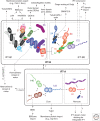The Intraflagellar Transport Machinery
- PMID: 27352625
- PMCID: PMC5046692
- DOI: 10.1101/cshperspect.a028092
The Intraflagellar Transport Machinery
Abstract
Eukaryotic cilia and flagella are evolutionarily conserved organelles that protrude from the cell surface. The unique location and properties of cilia allow them to function in vital processes such as motility and signaling. Ciliary assembly and maintenance rely on intraflagellar transport (IFT), the bidirectional movement of a multicomponent transport system between the ciliary base and tip. Since its initial discovery more than two decades ago, considerable effort has been invested in dissecting the molecular mechanisms of IFT in a variety of model organisms. Importantly, IFT was shown to be essential for mammalian development, and defects in this process cause a number of human pathologies known as ciliopathies. Here, we review current knowledge of IFT with a particular emphasis on the IFT machinery and specific mechanisms of ciliary cargo recognition and transport.
Copyright © 2016 Cold Spring Harbor Laboratory Press; all rights reserved.
Figures


References
-
- Adhiambo C, Blisnick T, Toutirais G, Delannoy E, Bastin P. 2009. A novel function for the atypical small G protein Rab-like 5 in the assembly of the trypanosome flagellum. J Cell Sci 122: 834–841. - PubMed
-
- Baker SA, Freeman K, Luby-Phelps K, Pazour GJ, Besharse JC. 2003. IFT20 links kinesin II with a mammalian intraflagellar transport complex that is conserved in motile flagella and sensory cilia. J Biol Chem 278: 34211–34218. - PubMed
Publication types
MeSH terms
Substances
LinkOut - more resources
Full Text Sources
Other Literature Sources
